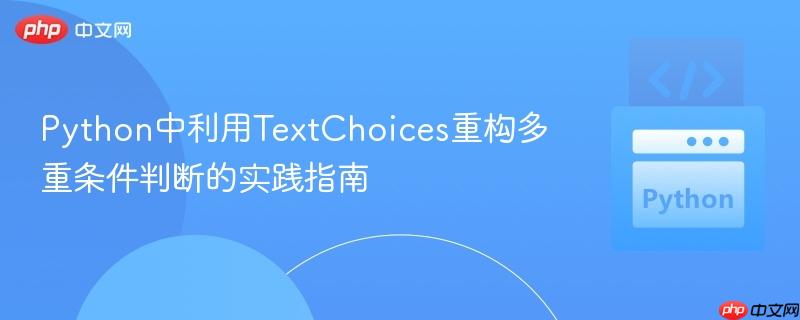
本文探讨了如何利用django的`textchoices`枚举类型,结合其可调用特性和动态方法分派,优雅地重构传统的多重`if`条件链。通过将特定逻辑封装到枚举成员的对应方法中,可以显著提升代码的可读性、可维护性和扩展性,避免冗余的条件判断,实现更清晰的业务逻辑分离。
优化冗余条件判断:从多重if到动态分派
在软件开发中,我们经常会遇到需要根据某个特定值执行不同操作的场景。一个常见的实现方式是使用一系列的if-elif-else或多重if语句。然而,当条件分支增多时,这种模式会导致代码变得冗长、难以阅读和维护,并违反了开闭原则(Open/Closed Principle),即对扩展开放,对修改封闭。
考虑以下一个典型的场景,一个API视图需要根据请求参数fields的值,返回不同类型的计数数据。原始代码可能如下所示:
from django.db.models import TextChoices from rest_framework.views import APIView from rest_framework.response import Response class CounterFilters(TextChoices): publications_total = "publications-total" publications_free = "publications-free" publications_paid = "publications-paid" comments_total = "comments-total" votes_total = "voted-total" class SomeView(APIView): def get(self, request, format=None): response_data = [] if "fields" in request.query_params: fields = request.GET.getlist("fields") for field in fields: if field == CounterFilters.publications_total: response_data.append({"type": CounterFilters.publications_total, "count": "some_calculations1"}) if field == CounterFilters.publications_free: response_data.append({"type": CounterFilters.publications_free, "count": "some_calculations2"}) if field == CounterFilters.publications_paid: response_data.append({"type": CounterFilters.publications_paid, "count": "some_calculations3"}) if field == CounterFilters.comments_total: response_data.append({"type": CounterFilters.comments_total, "count": "some_calculations4"}) if field == CounterFilters.votes_total: response_data.append({"type": CounterFilters.votes_total, "count": "some_calculations5"}) return Response(response_data)
这段代码的问题在于,每增加一种CounterFilters类型,就需要向get方法中添加一个新的if条件。这不仅增加了代码的复杂性,也使得业务逻辑分散,难以管理。
利用TextChoices的可调用特性进行重构
为了解决上述问题,我们可以利用python类和TextChoices枚举的特性,将每种计数类型的具体计算逻辑封装到CounterFilters枚举本身。核心思想是让CounterFilters的每个实例都变得“可调用”,并且在被调用时,能够根据其自身的枚举值动态地执行对应的计算方法。
立即学习“Python免费学习笔记(深入)”;
1. 增强CounterFilters枚举
首先,我们需要修改CounterFilters类,使其能够响应调用。这通过实现__call__魔术方法来完成。在__call__方法中,我们将使用getattr动态地查找并执行与当前枚举成员名称对应的方法。
from django.db.models import TextChoices # 假设 rest_framework 已经安装 from rest_framework.views import APIView from rest_framework.response import Response class CounterFilters(TextChoices): publications_total = "publications-total", "总发布数" publications_free = "publications-free", "免费发布数" publications_paid = "publications-paid", "付费发布数" comments_total = "comments-total", "总评论数" votes_total = "voted-total", "总投票数" def __call__(self, *args, **kwargs): """ 使CounterFilters实例可调用,并动态分派到对应的计算方法。 例如,CounterFilters.publications_total() 会调用 self.get_publications_total()。 """ # self.name 是枚举成员的名称,如 'publications_total' # 我们期望的方法名是 'get_publications_total' method_name = f'get_{self.name}' # 使用 getattr 获取并调用对应的方法 return getattr(self, method_name)(*args, **kwargs) # 以下是每种计数类型的具体计算逻辑 # 实际应用中,这些方法会包含真实的业务计算 def get_publications_total(self, request): # 示例:假设这里进行复杂的数据库查询或服务调用 print(f"Calculating {self.label} for user: {request.user}") return 42 def get_publications_free(self, request): print(f"Calculating {self.label} for user: {request.user}") return 14 def get_publications_paid(self, request): print(f"Calculating {self.label} for user: {request.user}") return 25 def get_comments_total(self, request): print(f"Calculating {self.label} for user: {request.user}") return 1337 def get_votes_total(self, request): print(f"Calculating {self.label} for user: {request.user}") return 1207
在上述代码中:
- 我们为CounterFilters添加了__call__方法,这使得CounterFilters.publications_total这样的枚举成员本身成为一个可调用的对象。
- __call__方法内部,self.name会返回枚举成员的名称(例如”publications_total”)。我们利用这个名称构造出对应的计算方法名(例如”get_publications_total”)。
- getattr(self, method_name)动态地获取CounterFilters实例上的指定方法。
- (*args, **kwargs)确保我们可以将任何必要的参数(例如request对象)传递给这些计算方法。
- 每个get_xxx方法都封装了特定于该计数类型的计算逻辑。
2. 简化SomeView的get方法
有了增强的CounterFilters,SomeView中的get方法现在可以大幅简化。它不再需要一系列的if条件,只需将请求的field字符串转换为CounterFilters的实例,然后直接调用该实例即可。
class SomeView(APIView): def get(self, request, format=None): # 假设 request.user 已经认证 # user = request.user response_data = [] if "fields" in request.query_params: fields = request.GET.getlist('fields') for field_value in fields: try: # 尝试将请求参数转换为 CounterFilters 实例 _filter_instance = CounterFilters(field_value) except ValueError: # 如果 field_value 不是有效的 CounterFilters 值,则跳过 print(f"Invalid filter field received: {field_value}") continue # 或者可以返回错误信息 else: # 调用 _filter_instance,它会自动分派到正确的 get_xxx 方法 # 将 request 对象作为参数传递给计算方法 count_value = _filter_instance(request) response_data.append( {'type': field_value, 'count': count_value} ) return Response(response_data)
在这个简化的get方法中:
- _filter_instance = CounterFilters(field_value):这行代码根据传入的字符串值创建一个CounterFilters的实例。如果field_value不是CounterFilters中定义的值,会抛出ValueError,我们通过try-except块进行捕获,确保代码健壮性。
- count_value = _filter_instance(request):这是关键所在。我们直接调用_filter_instance,由于CounterFilters中实现了__call__方法,它会自动执行get_{self.name}对应的方法,并将request对象传递过去。
优点与注意事项
这种重构方式带来了多方面的好处:
- 代码可读性与简洁性:SomeView中的逻辑变得非常清晰,不再有冗长的if链。
- 可维护性:每种计数类型的计算逻辑都封装在CounterFilters内部的独立方法中,修改或调试特定逻辑变得更容易。
- 可扩展性:当需要添加新的计数类型时,只需在CounterFilters中添加新的枚举成员和对应的get_xxx方法,而无需修改SomeView的get方法,完全符合开闭原则。
- 职责分离:CounterFilters负责定义和执行计算逻辑,SomeView只负责解析请求参数和组装响应,职责更加明确。
注意事项:
- 命名约定:确保枚举成员的名称(self.name)与对应的计算方法名(get_{self.name})之间存在明确且一致的约定。
- 参数传递:如果计算方法需要额外的上下文信息(如request对象、用户ID等),可以通过__call__方法将这些参数传递给get_xxx方法。
- 错误处理:对于无效的field_value,CounterFilters(field_value)会抛出ValueError。务必在视图层进行适当的错误处理,例如跳过、记录日志或返回客户端错误。
- 计算复杂性:如果计算逻辑非常复杂,并且需要访问大量外部依赖,可以考虑将这些计算方法进一步抽象到单独的服务层或管理器中,get_xxx方法仅作为这些服务的调用入口。
总结
通过巧妙地结合TextChoices枚举的可调用特性和Python的动态方法分派机制,我们可以有效地消除代码中冗余的多重if条件判断。这种模式不仅提升了代码的整洁度和可读性,更重要的是,它增强了代码的可维护性和可扩展性,使得在面对业务需求变化时,能够以更优雅、更高效的方式进行迭代和开发。这是一种值得在日常开发中推广的重构实践。


